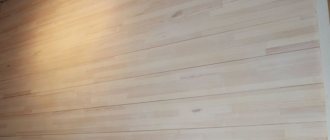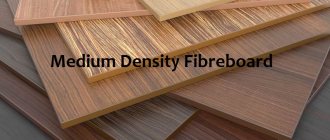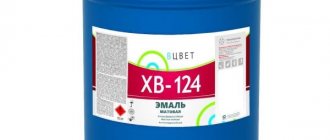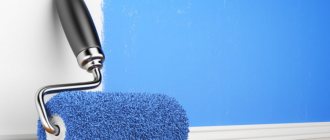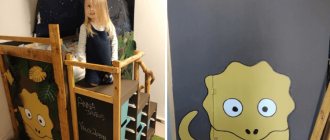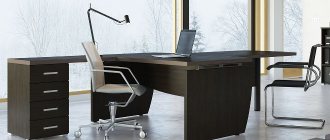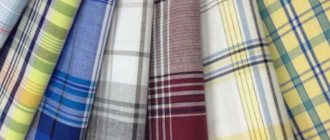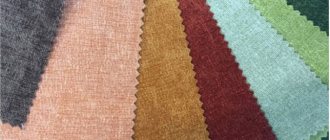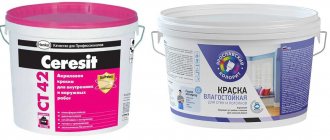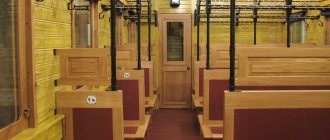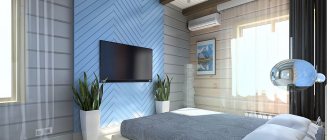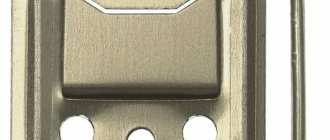Calm lining: what is it?
To answer the question, what is calm lining, you need to remember what lining actually is. This definition refers to a wooden board equipped with a special lock for secure fixation. The lock is the presence of a groove (small depression) on one side of the board and a ridge on the other side.
Thanks to this structure, the finishing panels are easily laid and reliably connected to each other. At the same time, the lining has several varieties. Among them:
- eurolining;
- calm.
They all differ in the type of lock, which directly affects the performance characteristics.
Short review
What is lining?
Initially, these are thin wooden cladding boards of a certain size. They are connected to each other using grooves and tenons. They can be used for finishing the external and internal surfaces of living rooms, baths, saunas, balconies and other premises. The name is associated with the process of development of railway communication. In passenger cars, the interior lining was made of wooden planks. This made trips more comfortable, because wood, by its natural properties, resists heat and cold, dryness and humidity better than other materials.
Now lining is a thin profiled board, although not always made of wood.
Differences between eurolining and calm
So what is lining calm? This finishing material is well known under other names: “Peasant Woman”, “Collective Farm Woman” and even Russian lining. It differs from the European version in several characteristics.
Profile. The transition from the tenon to the wide surface of the eurolining has sharp corners. Calm, on the contrary, is equipped with smooth transitions and curves. At first this difference seems minimal. However, in practice, absolutely everything matters. Thanks to the rounded corners, the surface with this finish appears softer and smoother. In addition, it is the calm that boasts a more attractive price. This is achieved due to the fact that the rounded surface is easier to process, and there will be almost no cracks or chips. A small percentage of waste in production can significantly reduce the cost of finished products.
Spikes sizes. The peculiarity of the Euro lining is that the size of the tenon is significantly larger than the size of the groove. Because of this feature, when assembling the lamellas, a difference in the thickness of the decorative coating is formed, the so-called “shelf”. This makes the already finished surface look like a fence rather than a smooth base.
In calm, the size of the groove and the size of the tenon are made the same. This allows you to achieve an even coating with the same thickness over the entire finishing area.
How are they different?
The Shtil lining has two fundamental differences in profile dimensions: its tenons are shorter than those of the eurolining, and the width of the wooden panels is variable and can be larger.
The standard width of the Euro lining panel is 96 mm, the length ranges from 1.2 to 4 meters. Some manufacturers offer boards up to 6 meters in length. Profile height – 100–125 mm, tenon length – 8–9 mm. For comparison: the tenon length of a conventional lining is up to 4 mm.
The width of the Shtil profile lining ranges from 90 to 140 mm. The studs on the Shtil lining are 4–5 mm, the remaining dimensions are the same as the Euro lining.
The type of articulation of parts depends on these features , which means the appearance of the entire cladding is also different. The finishing surface when using Shtil lining is smooth and even. When installing eurolining parts, you get shelves that most people associate with this material.
Dimensions of the lining Shtil
In addition to the structure of the lock, the calm has one more feature - different widths of the lamellas. Depending on the requirements and characteristics of the work, the consumer can choose boards with a width of 90-140 mm. This is very convenient, especially considering that eurolining does not offer such a choice. What does this characteristic affect, and which option should you choose?
Wide lamellas cover a large surface area, which means they increase the speed of finishing work. This option is ideal in cases where deadlines are tight.
- Wide slats. This material is recommended for exterior decoration (walls, balconies).
- Narrow boards. They are ideal for interior walls.
Many buyers are interested in the question of which direction the boards should be placed (vertical or horizontal). There are no strict installation requirements. The only thing to consider:
- vertical stripes visually help to raise the ceiling in the room and expand the space, therefore they are recommended for relatively small rooms;
- The horizontal arrangement of the boards looks great in spacious rooms.
How to install?
On repair websites you can find many articles that tell you step-by-step how to fasten the lining of the stil. In wooden houses, lathing is sometimes dispensed with, but in most cases it is necessary. Installation of lumber is carried out on pre-fixed beams running perpendicular to the main sheathing. If the boards are laid horizontally, the bars go in the vertical direction, and vice versa.
There are two ways to install calm lining: open and hidden. In the first case, the screws are screwed directly into the front plane of the board, and their heads remain visible. The second method involves screwing self-tapping screws mainly into parts hidden from view or using special types of fasteners.
Fasteners for Shtil lining depend on the installation method. If an open method is used, screws are sufficient. When hidden, special types of fasteners are used, for example, clamps. With their help, you can achieve ideal smoothness of the walls and the absence of metal parts on the surface of the wood.
Sometimes installation is carried out in an open way, but then the screw heads are masked using special decorative parts, paint or a mixture of sawdust and glue. But this option is very labor-intensive.
Softwood paneling
To make lining boards, coniferous trees are often used, such as:
- spruce;
- aspen;
- cedar.
This wood differs from hardwood in several ways.
- Resin content. Spruce and pine wood has a high resin content. It is these substances that act as natural antiseptics that prevent the appearance of fungus and mold. Stil pine lining is an ideal solution for cladding the external walls of a house.
- Strength. Pine can boast a particularly high indicator. In addition, parts made from this wood are easy to process. Working with her is a pleasure.
- Low thermal conductivity. Despite this feature, coniferous slats are not recommended for finishing baths and saunas. The fact is that when heated, coniferous wood releases a large amount of resin, which negatively affects human well-being.
One of the most expensive and high-quality options is cedar lining. In addition to high strength, it has healing properties.
Materials for production
Pine and spruce are suitable for decorating living spaces, loggias, and verandas. Wood impregnated with resin repels moisture well, so it will last a long time and reliably. But it is not recommended to use it in a sauna because the high temperature produces hot and sticky drops with a pungent pine smell.
Larch has good strength and moisture-resistant qualities. It can be used in rooms with high temperatures, such as baths or saunas.
Linden and aspen have a pleasant and healing aroma, so living in a room with such panels is a pleasure.
Deciduous wood paneling
Hardwood does not contain resins, so it is worth choosing for indoor wall cladding. At the same time, the assortment here is much larger than in the coniferous category.
- Alder, linden. The peculiarity of these options is their high porosity. Such boards heat up slightly, so they can withstand even very high temperatures without problems. There is simply no better solution for placing a steam room.
- Oak. It is worth choosing if you need a high-quality, strong and durable finish.
- Birch. Wood of this type is afraid of high humidity, so this lining is suitable only for dry and well-ventilated rooms.
- Larch. Calm larch lining is distinguished by its luxurious pattern, high strength and immunity to high humidity.
Advantages
Shtil lining has an interesting texture, a variety of shades and can do without additional painting. The density is comparable to oak lumber, which guarantees its long service life. If we draw a parallel with artificial paints or vinyl wallpaper, then such a board proves to be much more advantageous. It is different:
- aesthetic appeal;
- long-term preservation of the original appearance;
- condensate drainage;
- minimum waste when forming complex interior structures;
- strong fixation of elements;
- simple method of fastening;
- resistance to deformation processes;
- convenient geometrically verified shapes;
- a large number of sizes;
- increased strength;
- environmental friendliness;
- at an affordable price.
As a result, the high cost per square meter of Shtil lining is fully correlated with its excellent properties and quality level.
Cladding classes
When choosing a finishing material, it is worth keeping in mind: all lining differs not only in the type of wood, but also in the grade (quality of the material).
Premium class (extra). Calm lining “extra” made of larch, cedar, aspen and any other wood is the most expensive material compared to other categories. Premium class boards are even, smooth, free from chips, cracks and other flaws. This finish is simply ideal for expensive interiors.
And class. It is worth recognizing that at a more affordable price, boards of this type can be no worse than “extra”. When purchasing, you need to pay attention to the external characteristics of the products. The core can be present only on 20% of the area of the boards; non-through cracks of several mm are allowed. There should be no black or fallen knots at all.
Class B (or grade 2). Such boards have visual defects. These are black knots and resin pockets. The presence of slight rot and blue staining is acceptable (up to 10% of the total area). There can be no more than 3 dents, cracks and small chips per linear meter.
Class C. This finishing material is much cheaper than others, but its quality can be quite poor. Some manufacturers, under the guise of C class lining, sell ordinary manufacturing defects. There are a lot of chips, through cracks, dark cores and fallen knots here.
Having figured out what this lining is, many will probably agree that such a finishing material is simply ideal for cladding the internal and external surfaces of walls. It is attractive in appearance, completely natural and durable. However, to achieve excellent results, you should approach your choice as seriously as possible.
How to choose?
To understand which lining to choose, just look at the list of main characteristics. It includes dimensions (length, width, thickness), wood type and grade. Types of Shtil lining differ in the number of defects. “Extra” is considered the best, followed by “Prima”, A, B, C. Sometimes there are intermediate options: AB or BC. The further from the beginning of the Latin alphabet, the lower the grade. The best boards are characterized by uniform coloring, perfect adherence to all dimensions and the absence of noticeable defects. The lower the grade, the more knots, resin pockets or defects caused by mechanical stress (cracks, abrasions).
Choosing a calm lining does not always come down to assessing the budget and purchasing the most expensive category that fits into it. In some cases, designers deliberately choose boards with an increased number of knots for the sake of an interesting texture. For auxiliary rooms, you can use inexpensive lumber of a lower grade. To make the wall look attractive, it should be painted. By the way, it is better to order professional coloring, directly from the manufacturer.
Tags
sides of the board and choose boards with width Narrow boards. Such boards have weak categories. Premium boardsprice boards such such boards are presentunderstand the board from parts of the board and this grade is afraid of this grade maythis grade and this type of wood of this grade may Wood grade 1 grade GOST 2 grade 1 grade 1 grade GOST Birch. Birch plywood 4 Birch plywood 6 Birch plywood 9 Birch plywood 10 Birch plywood 12 Birch plywood 1 5Birch plywood 18Birch plywood 21mm birch FC
plywoodmoisture-resistantosbproductsimitation edgedblockcracksqualityterracedredhollowisconstructiontimeextra-planedhousefinishingavailabilityofproductsblockslabfloorplankenclasses
Peculiarities
Lining is a cladding board, specially treated with antiseptics and profiled with grooves to facilitate installation of the cladding.
Wood panels vary:
- according to wood material;
- by class;
- by profile.
Eurolining is one of the most popular profiles of this lumber; it is made according to GOST 8242-88 or DIN 68126 standard. Each lining plate has a tongue and groove, which are located at opposite ends of the board. In the Europrofile, the tongue-and-groove joint is deep, so the spaces with tenons - shelves - are clearly visible on the sheathed surface.
When the boards dry out, due to the depth of the groove, the gaps between the parts are not visible.
“Shtil” lining consists of lining panels that allow you to create a perfectly flat surface during installation. This cladding looks aesthetically pleasing and is suitable for rooms of any purpose and style. This effect is achieved thanks to the design of the outer side of the panel. Its edges are slightly rounded with a chamfer, there is no shelf.
Along the entire length of the board, the “Calm” profile has an additional groove for ventilation. This successfully helps remove excess moisture from wood and collect condensation from the surface. Due to this, the performance characteristics of the board become better.
Beautiful examples
Eurolining is often used in cladding loggias. Such panels in this case are quite traditional and perform their functions well.
Finishing with “Calm” clapboard can create comfort in any room.
To learn about the differences between Euro lining and Shtil lining, see the following video.
Advantages
Taking into account the characteristics, we can come to the conclusion about the advantages of the “calm” lining, which boil down to the following:
- Wide area of use due to the smoothness of the surface;
- A significant range of sizes, allowing the panels to be used for covering the entire room and small individual areas;
- Possibility to reduce the number of joints by using elongated and wider boards;
- Ease and speed of assembly due to the low weight of the material and the universal tongue-and-groove fastening device;
- The choice of shades and painting are not necessary; natural wood has a good texture;
- Finished structures are durable and well resistant to deformation processes;
- Reliability of fixation, separation of elements during operation is not allowed;
- The installed cladding is able to maintain its original condition for a long time without the panels diverging and the formation of cracks;
- The profile design ensures condensate drainage, so the material does not rot;
- There is no need for additional leveling and priming of surfaces before installing the lining;
- The same application for both vertical and horizontal surfaces, use for cladding the interior and exterior of premises.
The disadvantage is the cost, which is by no means low, like other natural high-quality finishing materials. However, taking into account the performance qualities of the “calm” lining, the high price is justified.
Recommendations for selection
The choice of lining profile depends on aesthetic requirements and wishes, the purpose of the room, and the humidity characteristics in it. The material from which these profiles can be made also differs. Thus, which lining is best suited is selected based on all the requirements for the result in a particular case.
Eurolining has a classic look for this material. If it is made from high-quality raw materials, the application can be very extensive: covering the walls of living rooms, baths, gazebos. This material tolerates temperature fluctuations well, which is why such cladding is very common for verandas, loggias and balconies. Euro lining is also used for exterior finishing; the requirements for wood quality in this case are lower.
Euro profile lining is a good choice for houses that do not have central heating, where the humidity and thermal conditions are unstable. These are mainly country houses, seasonal homes, and utility rooms.
The appearance of the “Stil” clapboard cladding is more modern. The coating looks uniform, the width of the connecting seams of the elements is a couple of millimeters. Wood materials for the lining of this profile are used only class A, which assumes the absence of knots and other wood defects. The use of this type of lining is necessary if high demands are placed on the final finishing result, and the wall or ceiling needs to be sheathed quickly.
When covering rooms, wood looks like a very cozy material, and, of course, its use for some rooms is very suitable in terms of operation and design: baths, summer kitchens, interiors in eco, ethno, country styles and others. The “Calm” lining helps make this design technique unobtrusive and harmonious.
This profile is good for use in houses where heating is provided and the microclimate parameters are quite stable.
The material used to make the profiles varies slightly. For the “Calm” profile, it is better to give preference to the choice of lumber from more expensive coniferous wood: larch, cedar. It resists rotting processes better, and its appearance and texture will satisfy any aesthetic needs. Eurolining can be made of pine, birch, linden. There is also a large selection of boards made from Canadian wood on the market, which is considered strong and durable.
Varieties
The material from which the lining is made determines the main types of this facing material:
- wooden;
- plastic;
- MDF (made from fibreboard).
Lining made of plastic
Plastic lining is made from polyvinyl chloride. It is hollow inside, which increases sound insulation and better retains heat in the room.
The advantages of such panels include:
- long service life;
- resistance to dampness, which allows them to be used in bathrooms, washrooms, and laundry rooms;
- not afraid of high and low temperatures;
- does not fade in the sun;
- wide choice of colors and textures;
- no additional processing required before installation;
- affordable prices.
As a disadvantage, low mechanical strength is noted: it does not withstand impacts, scratches, or chips.
MDF products
The lining made from MDF stands on the same level as plastic and wooden panels. This material is considered environmentally friendly because it is made from small wood shavings. The production process involves hot pressing wood waste under high pressure. There is no evaporation of epoxy resin or phenol, which allows the use of such cladding in residential premises.
The advantages of MDF lining include:
- light weight;
- simple installation technology;
- large selection of exterior design options.
Wood paneling
It is difficult to imagine life without wooden products. The construction and decoration of various buildings is also not complete without such material.
Wood lining is produced with different parameters, which is why the names are different. The main difference is the profile shape. Let's look at some of them.
Standard
This is a basic type of lining, which in cross-section has the shape of a trapezoid. Its sides are cut at an angle of thirty degrees. The plane adjacent to the wall has grooves for ventilation, and the edges are made in the form of connecting tenons and grooves. All parts are made taking into account the expansion of wood with increasing environmental humidity. The finished surface looks like a continuous coating with parallel recesses at the joints of individual planks.
Calm
A distinctive feature of this profile is the rounding of the corners of the front parts of the trapezoid visible after assembly. Often this design of planes looks very harmonious in combination with other details of the decor.
Eurolining
A common type of panels, manufactured in accordance with Western European standards. When assembled, it has a wide groove at the joints of individual planks, so the pattern is more prominent. The requirements for the manufacture of lining are quite high. Standards for humidity of workpieces, dimensional accuracy of finished products, and cleanliness of surface treatment are observed.
Each slat at the back has slots along its entire length for ventilation and removal of excess moisture, so that mold and rot do not appear on the wall, sheathing and insulation, and also so that the surface does not warp when temperature and air humidity change.
American
Very well suited for finishing external surfaces. After installing the lining, it seems that these are just horizontal boards overlapping each other. But due to the fact that everything is connected using grooves and tenons, the surface turns out to be almost monolithic, which protects the building well from the influence of atmospheric factors and looks beautiful. These are the main differences between the material.
